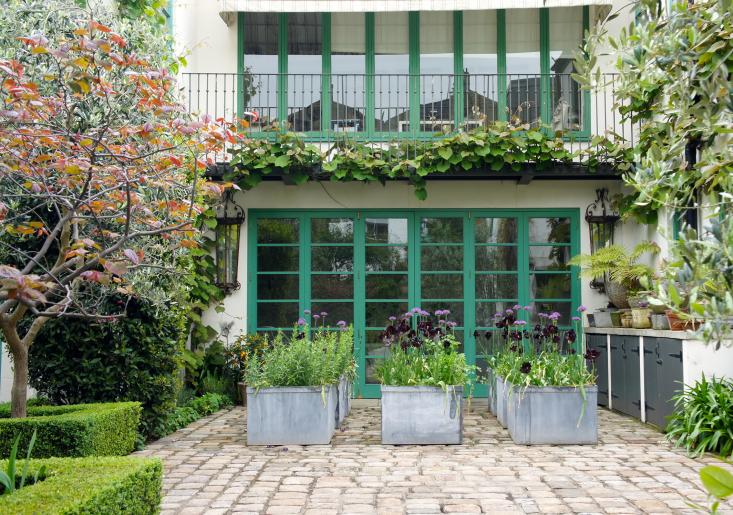A visit to textile designer Neisha Crosland’s London garden is always an opportunity for sleuthing eyes to uncover what may have inspired her latest designs; and after an extended winter, we were delighted when she contacted us to say that her black tulips were ready for viewing. This time we contacted her garden designer Sean Walter from The Plant Specialist to get the inside story.
N.B.: Crosland’s designs are available in her recently launched Online Shop.
Photography by Christine Chang Hanway for Gardenista.
Gardenista: What can you tell us about the purple color scheme in Neisha Crosland’s spring garden?
Sean Walter: The containers are planted primarily with deciduous herbs, which are quite bare in the winter and early spring. To extend the interest in this very focal area, tulips were used to give the first bit of color, followed by the allium as a second color. The purple and plum colors work well with the emerging cercis leaves, and the overall subdued effect is not too overpowering in the space.
Gardenista: The names of these two flowers?
Sean Walter: They are ‘Black Parrot’ tulips and ‘Purple Sensation’ alliums.
Planning your fall bulb order? ‘Black Parrot’ Tulips are $11.95 for 10 bulbs and ‘Purple Sensation’ Allium bulbs are $14.95 for 10; both available from Eden Brothers.
Gardenista: As we look across, please tell us about how this garden is zoned.
Sean Walter: There are three distinct zones in this garden; the cobbled mews entrance where cars once drove (from where this photo is taken), a sunken terrace off the drawing room and kitchen, and a stepped lawn.
Gardenista: Everyone wants to know more about these trees. Please tell us what they are and what sort of trimming is required to get them to this shape?
Sean Walter: They are Quercus ilex (Holm Oak), designed primarily to give a large evergreen presence and structure to the lawn area as well as providing some evergreen screening to the master bedroom. Like most evergreens, one trim a year with a hedge pruner should be sufficient.
Gardenista: When do you use box hedging?
Sean Walter: The primary purpose of box hedging is to help divide and structure the space, but at the same time the box hedging offers some ornamentation and winter interest.
Gardenista: The planting scheme in the well in the boxed hedge provides a focal point in the garden. What can you tell us about the plant layers?
Sean Walter: The tree is Cercis canadensis ‘Forest Pansy’. The cercis is underplanted with purple iris, which gives spring interest and color while the sword foliage is still interesting for the rest of the season.
Gardenista: We’d love to know more about your planting strategy at the border of the stepped lawn.
Sean Walter: The lawn and quercus trees are surrounded by a 1.5-meter border, which is mainly planted with deciduous perennials. The buxus balls provide a structural rhythm to the plantings and are complemented by grasses in the summer.
Gardenista: What do you have growing on the boundary walls?
Sean Walter: The main boundary wall is predominantly cloaked with evergreen Trachelospermum jasminoides (Italian Jasmine) and the remaining wall is covered with espaliered Perrottia persica (Persion Ironwood), which produces wonderful color in the autumn.
Gardenista: What grows in the containers during the summer?
Sean Walter: We think of the containers as flexible space in which we can grow herbs or vegetables.
Gardenista: How did this loquat tree survive this winter?
Sean Walter: This ornamental citrus typically lives in the mews entrance during the cold months, and we move it outside during the summer to get better light.
Did you miss the post on Crosland’s winter garden? See Paris in London: Neisha Crosland’s Garden Oasis.



















Have a Question or Comment About This Post?
Join the conversation